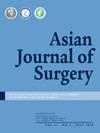Effectiveness of sacral neuromodulation with 3D-printing and ultrasound localization for treating neurogenic bladder in patients with pelvic structural anomalies
IF 3.8
3区 医学
Q1 SURGERY
引用次数: 0
Abstract
Objective
To assess the efficacy and safety of Sacral Neuromodulation (SNM) in conjunction with 3D printing and ultrasound localization for treating patients with neurogenic bladder and pelvic structural anomalies.
Methods
This prospective study involved 56 patients diagnosed with neurogenic bladder and pelvic anomalies. They were treated with SNM from January 2022 to December 2023. Patients were split into study and control groups based on the origins of their pelvic anomalies, with each group comprising 28 individuals. The study group underwent preoperative 3D printing and intraoperative ultrasound-assisted puncture, whereas the control group utilized intraoperative X-ray-assisted puncture. Metrics compared included the number of punctures, average puncture duration, intraoperative SNS tuning time, effective initial voltage, postoperative testing duration, phase two conversion rates, and the incidence of bleeding and infection.
Results
The study group experienced significantly fewer punctures compared to the control group (2.21 ± 0.92 vs 9.29 ± 4.37) (P < 0.01), had a shorter average puncture duration (5.71 ± 2.69 min vs. 28.60 ± 9.69 min) (P < 0.01), and required a lower effective initial voltage (0.87 ± 0.23v vs. 1.38 ± 0.52v) (P < 0.01). X-ray exposure was eliminated in the study group, in contrast to 11.51 ± 4.62 mAs in the control group(P < 0.01). The phase two implantation rates were 67.8 % for the study group and 57.1 % for the control group(P = 0.04). No surgery-related complications occurred in either group.
Conclusion
Combining preoperative 3D printing with intraoperative ultrasound-assisted puncture significantly improves the accuracy of SNM placement, reduces surgery time, and eliminates X-ray exposure for both doctors and patients. This method is both safe and effective for patients with neurogenic bladder and pelvic anomalies.
利用三维打印和超声定位技术治疗骨盆结构异常患者神经源性膀胱的骶神经调控效果。
目的评估骶神经调控(SNM)与 3D 打印和超声定位相结合治疗神经源性膀胱和骨盆结构异常患者的有效性和安全性:这项前瞻性研究涉及 56 名被诊断为神经源性膀胱和骨盆异常的患者。他们在 2022 年 1 月至 2023 年 12 月期间接受了 SNM 治疗。根据骨盆异常的起源将患者分为研究组和对照组,每组 28 人。研究组进行术前3D打印和术中超声辅助穿刺,而对照组则采用术中X光辅助穿刺。比较的指标包括穿刺次数、平均穿刺时间、术中 SNS 调整时间、有效初始电压、术后测试时间、第二阶段转换率以及出血和感染发生率:结果:与对照组相比,研究组的穿刺次数明显减少(2.21 ± 0.92 vs 9.29 ± 4.37)(P 结论:研究组的穿刺次数明显少于对照组(2.21 ± 0.92 vs 9.29 ± 4.37):将术前 3D 打印与术中超声辅助穿刺相结合,可显著提高 SNM 置入的准确性,缩短手术时间,并避免医生和患者接触 X 光。这种方法对神经源性膀胱和骨盆异常患者既安全又有效。
本文章由计算机程序翻译,如有差异,请以英文原文为准。
求助全文
约1分钟内获得全文
求助全文
来源期刊

Asian Journal of Surgery
医学-外科
CiteScore
3.60
自引率
31.40%
发文量
1589
审稿时长
33 days
期刊介绍:
Asian Journal of Surgery, launched in 1978, is the official peer-reviewed open access journal of the Asian Surgical Association, the Taiwan Robotic Surgery Association, and the Taiwan Society of Coloproctology. The Journal is published monthly by Elsevier and is indexed in SCIE, Medline, ScienceDirect, Scopus, Embase, Current Contents, PubMed, Current Abstracts, BioEngineering Abstracts, SIIC Data Bases, CAB Abstracts, and CAB Health.
ASJSUR has a growing reputation as an important medium for the dissemination of cutting-edge developments in surgery and its related disciplines in the Asia-Pacific region and beyond. Studies on state-of-the-art surgical innovations across the entire spectrum of clinical and experimental surgery are particularly welcome.
The journal publishes original articles, review articles, and case reports that are of exceptional and unique importance. The journal publishes original articles, review articles, and case reports that are of exceptional and unique importance.
 求助内容:
求助内容: 应助结果提醒方式:
应助结果提醒方式:


